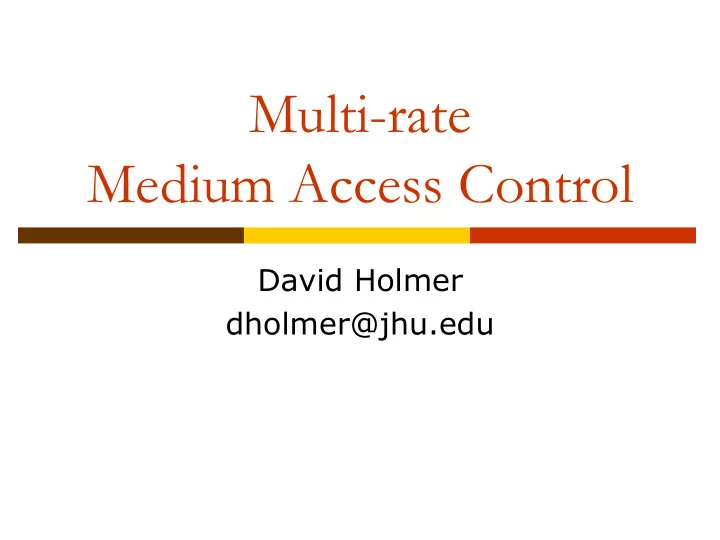

Multi-rate Medium Access Control David Holmer dholmer@jhu.edu
What is Multi-Rate? � Ability of a wireless card to automatically operate at several different bit-rates (e.g. 1, 2, 5.5, and 11 Mbps for 802.11b) � Part of many existing wireless standards (802.11b, 802.11a, 802.11g, HiperLAN2…) � Virtually every wireless card in use today employs multi-rate
Example Carrier Modulations � Binary Phase Shift Keying � One bit per symbol � Made by the carrier and its inverse � Quadrature Phase Shift Keying � Two bits per symbol � Uses quadrature carrier in addition to normal carrier (90 ° phase shift of carrier) � 4 permutations for the inverse or not of the two carriers
Example Carrier Modulations (cont.) � 16 - Quadrature Amplitude Modulation � 4 bits per symbol � Also uses quadrature carrier � Each carrier is multiplied by +3, +1, -1, or -3 (amplitude modulation) � 16 possible combinations of the two multiplied carriers
Example Carrier Modulations (cont.) � 64 - Quadrature Amplitude Modulation � 6 bits per symbol � Also uses quadrature carrier � Each carrier is multiplied by +7, +5, +3, +1, -1, -3, -5, or -7 (amplitude modulation) � 64 possible combinations of the two multiplied carriers
802.11a Rates resulting from Carrier Modulation and Coding
Advantage of Multi-Rate? � Direct relationship between 1 Mbps communication rate and the 2 Mbps channel quality required for 5.5 Mbps that rate 11 Mbps � As distance increases, channel quality decreases � Therefore: tradeoff between communication range and link speed � Multi-rate provides flexibility to meet both consumer demands Lucent Orinoco 802.11b card ranges using NS2 two-ray ground propagation model
Throughput vs. Distance for 802.11a
802.11 Frame Exchange Overhead � Exchange means not all time is spend sending actual data Sender RTS DATA cw CTS ACK Receiver Medium time used for transmission Actual time sending application data
Multi-rate Frame in 802.11b
802.11b Frame Exchange Duration 4.55 Mbps MAC Overhead Data 11.0 Rate (Mbps) 3.17 Mbps 5.5 2.0 1.54 Mbps 0.85 Mbps 1.0 0 1 2 3 4 5 6 7 8 9 10 11 12 13 14 Medium Time (milliseconds) Medium Time consumed to transmit 1500 byte packet
Multi-rate Frame in 802.11a 52 us
Hops vs. Throughput � Since the medium is shared, adjacent transmissions compete for medium time 1 2 3 � Effective end-to-end throughput decreases when sending across multiple hops
Effect of Transmission Source Destination X X X X X X X 1 2 3 4 5 6 7 8 Request to Send (RTS) Clear to Send (CTS) DATA ACK
Multi-Hop Throughput Loss (TCP) 4.0 1.0 Mbps 2.0 Mbps 3.5 5.5 Mbps 3.0 Throughput (Mbps) 11.0 Mbps 2.5 2.0 1.5 1.0 0.5 11.0 Mbps 0.0 5.5 Mbps 1 2 2.0 Mbps 3 4 5 1.0 Mbps 6 7 Hops 8 9
Auto Rate Protocols � Selects the rate to use for a packet � ARF � Adaptive based on success/failure of previous packets � Simple to implement � Doesn’t require the use of RTS CTS or changes to 802.11 spec � Receiver Based Auto Rate (RBAR) � Uses SNR measurement of RTS to select rate � Faster & more accurate in changing channel � Requires some tweaks to the header fields � Opportunistic Auto Rate (OAR) � Adds packet bursting to RBAR � Allows nodes to send more when channel conditions are good � Implements temporal fairness instead of packet fairness
MAC Layer Fairness Models � Per Packet Fairness : If two adjacent senders continuously are attempting to send packets, they should each send the same number of packets . � Temporal Fairness : If two adjacent senders are continuously attempting to send packets, they should each be able to send for the same amount of medium time. � In single rate networks these are the SAME!
Temporal Fairness Example Per Packet Fairness 11 Mbps 802.11 OAR Packet Temporal Fairness Fairness 1 Mbps 11 Mbps 0.896 3.533 Link Temporal Fairness 1 Mbps Link 0.713 0.450 11 Mbps Total 1.609 3.983 Throughput 1 Mbps
Recommend
More recommend